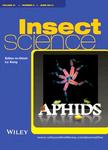Effects of single and dual species herbivory on the behavioral responses of three thrips species to cotton seedlings
Effects of single and dual species herbivory on the behavioral responses of three thrips species to cotton seedlings作者机构:School of Biological Sciences The University of Queensland St. Lucia Queensland 4072 Australia Cotton Research Unit CSIRO Agriculture Flagship Locked Bag 59 Narrabri NSW 2390 Australia
出 版 物:《Insect Science》 (昆虫科学(英文版))
年 卷 期:2017年第24卷第4期
页 面:684-698页
核心收录:
学科分类:0710[理学-生物学] 0830[工学-环境科学与工程(可授工学、理学、农学学位)] 09[农学] 0904[农学-植物保护] 0901[农学-作物学] 090402[农学-农业昆虫与害虫防治] 0713[理学-生态学]
基 金:Cruiser Research and Development Fund
主 题:attraction dual-herbivory Frankliniella occidentalis Frankliniella schultzei induced responses predictability simultaneous damage Thrips tabaci
摘 要:This study investigated the olfactory responses of 3 thrips species [Frankliniella schultzei Trybom, E occidentalis Pergrande and Thrips tabaci Lindeman (Thysanoptera: Thripidae)] to cotton seedlings [Gossypium hirsutum L. (Malvales: Malvaceae)] simulta- neously damaged by different combinations of herbivores. Cotton seedlings were damaged by foliar feeding Tetranychus urticae Koch (Trombidiforms: Tetranychidae), Helicoverpa armigera Hibner (Lepidoptera: Noctuidae), Aphis' gossypii Glover (Hemiptera: Aphidi- dae) or root feeding Tenebrio molitor L. (Coleoptera: Tenebrionidae). Thrips responses to plants simultaneously damaged by 2 species of herbivore were additive and equivalent to the sum of the responses of thrips to plants damaged by single herbivore species feeding alone. For example, E occidentalis was attracted to T. urticae damaged plants but more attracted to undamaged plants than to plants damaged by H. armigera. Plants simultane- ously damaged by low densities of T. urticae and H. armigera repelled E occidentalis but as T. urticae density increased relative to H. armigera density, E occidentalis attraction to coinfested plants increased proportionally. Thrips tabaci did not discriminate between un- damaged plants and plants damaged by H. armigera but were attracted to plants damaged by T. urticae alone or simultaneously damaged by T. urticae and H. armigera. Olfactometer assays showed that simultaneous feeding by 2 herbivores on a plant can affect predator- prey interactions. Attraction of F. occidentalis to plants damaged by its T. urticae prey was reduced when the plant was simultaneously damaged by H. armigera, T. molitor, or A. gossypii and F. schultzei was more attracted to plants simultaneously damaged by T. urticae and H. armigera than to plants damaged by T. urticae alone. We conclude that plant responses to feeding by I species of herbivore are affected by responses to feeding by other herbivores. These plant-mediated interactions between herbivo



